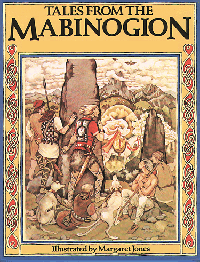

|
|||||
The Mabinogion
The Welsh Mythology
Background informationThe tales of the Mabinogion are not the product of any single hand; evolving over the centuries, passed from storyteller to storyteller, until some master bard put them together around the twelfth century. Its contents draw upon the myths and history of Celtic Britain: four branches of a storyline set largely within the confines of Wales and the otherworld.
The tales create a dreamlike atmosphere and preserve much of the primitive, fascinating world of Celtic myth. They exemplify the heroic and idealistic world of Celtic literature. The Mabinogion does not seem to have been very well known until its translation into English in 1849 when Lady Charlotte Guest's version appeared. The tales comprise an ensemble of parts, the first four "Pwyll", "Branwen", "Manawydan", and "Math" comprising the Four Branches of the Mabinogi.
The Mabinogion are found in the "Red Book of Hergest", a large fourteenth-century manuscript kept at Jesus College, Oxford. An earlier manuscript called 'The White Book of Rhydderch' (c. 1325CE) is incomplete but more than likely contained all the tales when it was whole. Fragments of these tales appear elsewhere, the earliest of which is believed to be 'Peniarth 6' which dates to c. 1225. The stories were probably drawn up in their present shape towards the end of the twelfth century, but the stories are of much greater antiquity, some belonging even to the more distant past of Celtic paganism and to the period of Gallo-Breton unity.
It is interesting to note that in the main "Four Branches" there is no mention of Arthur. Besides these four tales, the Mabinogion includes two from romantic British history ("The Dream of Macsen Wledig" and "The Story of Lludd and Llefelys"), two more interesting ones ("The Dream of Rhonabwy" and "Culhwch and Olwen"), "Taliesin", and, finally, three tales ("Owain or The Lady of the Fountain", "Geraint the Son of Erbin", "Peredur the Son of Efrawc") which show a marked kinship with certain medieval French tales.
Most of the principal characters in the "Four Branches" - the only stories which are refferd to as Mabinogi - come from two distinct clans of gods. Bran, Branwen and Manawyddan are the children of Llyr, the sea god and mythical king of the early Britons, who later found another manifestation as Shakespeare's King Lear. The three-volume edition with English translation by Lady Charlotte Guest was printed by Llandovery in 1849 with the English translation alone appearing in an edition of 1879. The Welsh text has been printed in a diplomatic edition, "The Red Book of Hergest", by J. Rhys and J. Gwenogfryn Evans (Oxford, 1887). Lady Guest's translation has been re-edited with valuable notes by Alfred Nutt (London, 1902) |
|||||
Top
